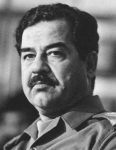 Saddam Hussein (1937-2006) was the long-serving president of Iraq, ruling from July 1979 until his overthrow in April 2003. As leader of Iraq Saddam’s relationship with his fellow Middle Eastern rulers, as well as Cold War powers like the United States and Soviet Russia, was fluid and complex. Saddam was born into a family of shepherds near the town of Tikrit in northern Iraq. He never knew his father, who disappeared before Saddam was born, and was instead raised by his brutal stepfather and uncles. Saddam attended high school in Baghdad, later commencing a law degree. He abandoned his legal studies to join the Ba’ath Party, a revolutionary group that sought the formation of a single, socialist Arab state. In July 1958, shortly after Saddam joined the Ba’athists, they deposed Iraq’s King Faisal and seized control of the government. Saddam became involved in the Ba’ath movement’s internal power struggles and spent most of the 1960s in prison or living in exile.
Saddam Hussein (1937-2006) was the long-serving president of Iraq, ruling from July 1979 until his overthrow in April 2003. As leader of Iraq Saddam’s relationship with his fellow Middle Eastern rulers, as well as Cold War powers like the United States and Soviet Russia, was fluid and complex. Saddam was born into a family of shepherds near the town of Tikrit in northern Iraq. He never knew his father, who disappeared before Saddam was born, and was instead raised by his brutal stepfather and uncles. Saddam attended high school in Baghdad, later commencing a law degree. He abandoned his legal studies to join the Ba’ath Party, a revolutionary group that sought the formation of a single, socialist Arab state. In July 1958, shortly after Saddam joined the Ba’athists, they deposed Iraq’s King Faisal and seized control of the government. Saddam became involved in the Ba’ath movement’s internal power struggles and spent most of the 1960s in prison or living in exile.
By the early 1970s, Saddam had returned to become a driving force in both the party and its government. Though he held no portfolio or office, Saddam became the most influential figure in the Ba’athist government. He oversaw significant economic reforms, including the nationalisation of foreign oil interests in Iraq. The revenue created by these changes was used to fund significant military growth, as well as social welfare, free education and other reforms. Saddam worked to build up support for the Ba’ath Party – and where support could not be obtained he used brutal repression to force obedience. Under Saddam’s rule Iraq – which had long been a patchwork of tribes, clans, sectarian groups and religious divisions – was melded into a unified state. By 1979 Saddam had accumulated enough support and control over the Ba’ath Party to seize absolute leadership. In July he ordered the arrest of 68 party leaders, one-third of whom were promptly executed. Hundreds of others were killed over the weeks that followed. Saddam was now the undisputed dictator of Iraq.
With regard to foreign policy, Saddam trusted nobody and managed his relationships simply to benefit his own agenda. In 1972 he aligned his country with the Soviet Union, chiefly to strengthen the Iraqi military. Iraq received arms, advisors and training from the USSR and KGB, as well as East Germany and the Stasi. In the mid-1970s Saddam gravitated away from the Soviets and began obtaining arms and military equipment – and even a nuclear reactor – from France. Saddam’s shift away from Moscow, as well as his war against Iran (beginning September 1980), made the Western powers more willing to deal with him. During the 1980s Iraq received military aid and weapons technology from the United States, Britain and West Germany. In December 1983 an American envoy, Donald Rumsfeld, later a US defence secretary, visited Iraq and was photographed shaking hands with Saddam. The Reagan administration continued to support and supply Saddam for the duration of the Iran-Iraq War (1980-88). This American support included refusing to act after Saddam used chemical weapons against Kurdish civilians.

As the Cold War wound down, Saddam replaced the Soviet Union as the United States’ most significant villain. In August 1990 Saddam attempted to extend Iraqi influence by invading the small but oil-rich nation of Kuwait. This invasion prompted an immediate response from US president George Bush, who ordered US forces to expel Saddam’s troops from Kuwait (First Gulf War, 1990-91). Iraq was not invaded but was subjected to years of economic sanctions and embargoes. These sanctions crippled Iraq’s domestic economy and caused significant human suffering. In the wake of the September 11th 2001 terrorist attacks, US president George W. Bush escalated his rhetoric against the Ba’athist regime. Bush identified Saddam as a brutal tyrant, a sponsor of terrorism and a stockpiler of chemical and biological weapons. In March 2003 an American-led five-nation coalition invaded Iraq, without the backing of the United Nations. Saddam’s military, weakened by years of sanctions, proved ineffective and his government collapsed within a few weeks. In December 2003 US forces found the former dictator hiding in a hole near his hometown. He was arrested, interrogated and handed over to Iraqi authorities for trial. Saddam Hussein was found guilty and executed by hanging in December 2006.
Content on this page is © Alpha History 2018-23. This content may not be republished or distributed without permission. For more information please refer to our Terms of Use.
This page was written by Jennifer Llewellyn and Steve Thompson. To reference this page, use the following citation:
J. Llewellyn & S. Thompson, “Saddam Hussein”, Alpha History, accessed [today’s date], https://alphahistory.com/coldwar/saddam-hussein/.
